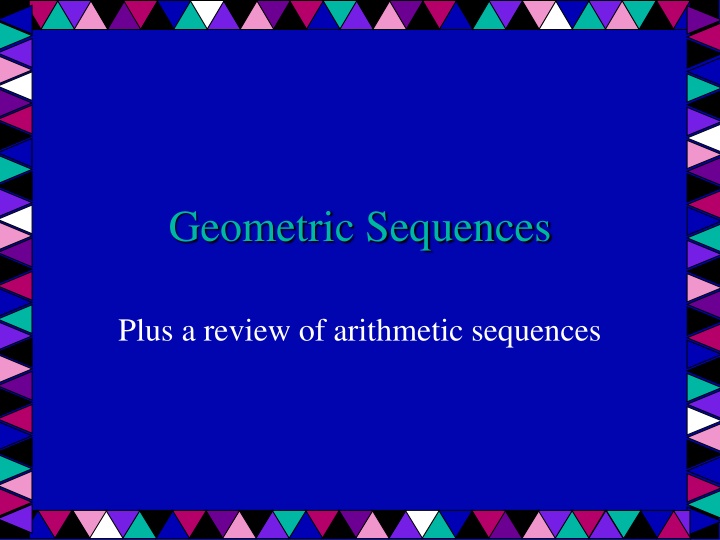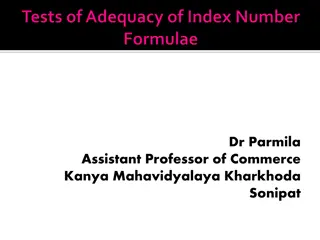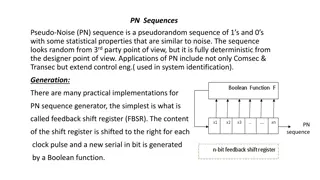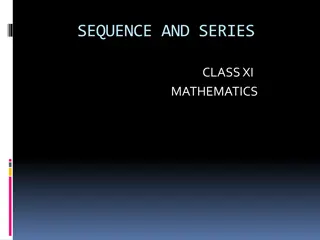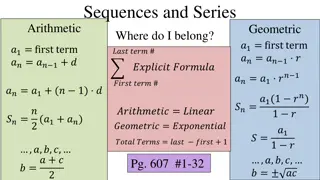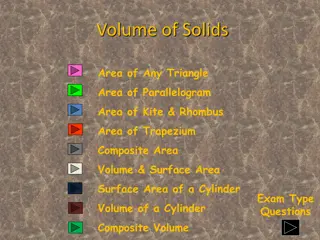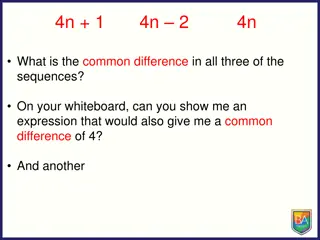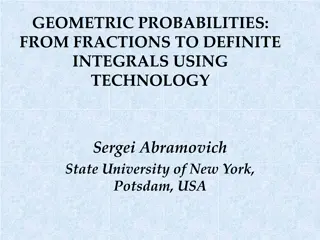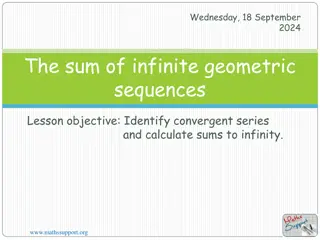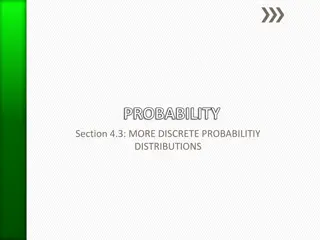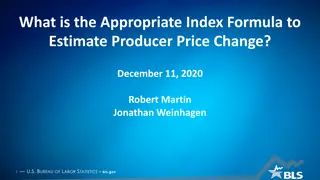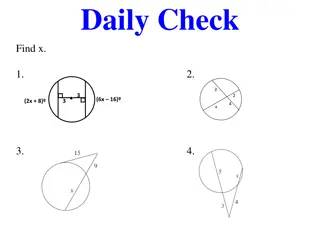Geometric Sequences: Definitions, Examples, and Formulas
Delve into the world of geometric sequences with a comprehensive overview of definitions, key concepts, examples, and essential formulas. Explore the common ratio, differences between arithmetic and geometric sequences, find common ratios in given examples, and solve sample problems to solidify your understanding. Discover the significance of arithmetic and geometric formulas, and test your knowledge with fun sequence guessing games.
Download Presentation

Please find below an Image/Link to download the presentation.
The content on the website is provided AS IS for your information and personal use only. It may not be sold, licensed, or shared on other websites without obtaining consent from the author.If you encounter any issues during the download, it is possible that the publisher has removed the file from their server.
You are allowed to download the files provided on this website for personal or commercial use, subject to the condition that they are used lawfully. All files are the property of their respective owners.
The content on the website is provided AS IS for your information and personal use only. It may not be sold, licensed, or shared on other websites without obtaining consent from the author.
E N D
Presentation Transcript
Geometric Sequences Plus a review of arithmetic sequences
Definitions Definitions: (yes, that's right, this is important, know these!) A sequence is a set of numbers, called terms, arranged in some particular order. An arithmetic sequence is a sequence with the difference between two consecutive terms constant. The difference is called the common difference. ( isn't that clever!) A geometric sequence is a sequence with a common ratio, r. (cleverness two!) i.e. The ratio of successive terms in a geometric sequence is a constant called the common ratio, denoted r.
Examples: Find the common ratio of the following: 1) 1, 2, 4, 8, 16, ... r = 2 2) 27, 9, 3, 1, 1/3, ... r = 1/3 3) 3, 6, 12, 24, 48, ... r = 2 4) 1/2, -1, 2, -4, 8, ... r = -2
Examples: Find the next term in each of the previous sequences. 1) 1, 2, 4, 8, 16, ... 32 2) 27, 9, 3, 1, 1/3, ... 1/9 3) 3, 6, 12, 24, 48, ... 96 4) 1/2, -1, 2, -4, 8, ... -16
Let's play guess the sequence!: I give you a sequence and you guess the type. 1. 3, 8, 13, 18, 23, . . . 2. 1, 2, 4, 8, 16, . . . 3. 24, 12, 6, 3, 3/2, 3/4, . . . 4. 55, 51, 47, 43, 39, 35, . . . 5. 2, 5, 10, 17, . . . 6. 1, 4, 9, 16, 25, 36, . . .
Answers! 1) Arithmetic, the common difference d = 5 2) Geometric, the common ratio r = 2 3) Geometric, r = 1/2 4) Arithmetic, d = -4 5) Neither, why? (How about no common difference or ratio!) 6) Neither again! (This looks familiar, could it be from geometry?)
This is important! Arithmetic formula: an = a1 + (n - 1)d an is the nth term, a1 is the first term, and d is the common difference. Geometric formula: an= a1. r (n - 1) an is the nth term, a1 is the first term, and r is the common ratio.
Sample problems: Find the first four terms and state whether the sequence is arithmetic, geometric, or neither. 1) an = 3n + 2 2) an = n2 + 1 3) an = 3*2n
Answers: 1) an = 3n + 2 To find the first four terms, in a row, replace n with 1, then 2, then 3 and 4 Answer: 5, 8, 11, 14 The sequence is arithmetic! d = 3
2) an = n2 + 1 To find the first four terms, do the same as above! Answer: 2, 5, 10, 17 The sequence is neither. Why?
3) an = 3*2n Ditto for this one ( got it by now?) Answer: 6, 12, 24, 48 The sequence is geometric with r = 2
Find a formula for each sequence. 1) 2, 5, 8, 11, 14, . . . Work: It is arithmetic! So use the arithmetic formula you learned! a1 = 2, look at the first number in the sequence! d = 3, look at the common difference! Therefore, an = 2 + (n - 1)3 and simplifying yields : an = 3n -1 ( tada!) Try putting in 1, then 2, then 3, etc. and you will get the sequence!
2) 4, 8, 16, 32, . . . Work: It is geometric! So use the geometric formula you learned up yonder! a1 = 4, look at the first number in the sequence! r = 2, look at the common ratio!Therefore, an = 4 * 2 (n - 1) and simplifying gives us: an = 2 * 2n (Yikes stripes! Where did this come from. rewrite 2(n - 1) as 2n . 2- 1 and cancel with the four!) Try putting in 1, 2, 3, etc and see if you get the sequence back!
3) 21, 201, 2001, 20001, . . . Work: Bummer! It's not geometric or arithmetic. What do I do now? Don't panic! Use your head and think! Think of the sequence as (20 +1), (200+1), (2000 + 1), (20000 + 1), . . . Then as this sequence:[(2)(10) +1],[(2)(100) +1], [(2)(1000) +1], [(2)(10000) +1] Wait! Hold on here! I see a pattern! Cool, without a formula! Powers of 10! How does this grab ya! an = 2*10n + 1 Does this work? Try it and see!
Find the indicated term of the sequence. 1) sequence is arithmetic with t1 = 5 and t7 = 29. Find t53 Work: Use the formula! 29 = 5 + 6d Where oh where did I get that! Substitution! 24 = 6d means d = 4 t53 = 5 + 52.4 = 213
2) Find the number of multiples of 9 between 30 and 901. Work: What's the first multiple of 9 in the range? How about 36. What's the last multiple of 9 in the range? How about 900. Use the formula: 900 = 36 + 9(n - 1) and solve for n! 864 = 9n - 9 873 = 9n 97 = n There are 97 multiples in the range!
How to find the sum of a finite Geometric Series Sn= a1(1 - rn)/(1 - r) where r is the common ratio and (r doesn't = 0) To find the sum of a finite geometric series, you need to know three things: the first term, how many terms to add and the common ratio!! (piece of cake!)
Definition geometric series - the expression formed by adding the terms of a geometric sequence. Finding the Sum of the First n Terms of a Geometric Sequence. Use Sn = [a1(1 - rn)/(1 - r)], Sn is the sum of the first n terms. Substitute the n, a, and r values into Sn = [a1(1 - rn)/(1 - r)]. Simplify to find the sum.
Example problem: Find the sum of the first 10 terms of the geometric series: 4, 8, 16, 32, 64, . . . t1 = 4 r = 2t10 = 4 . 29 = 2048 (This is the formula for a geometric sequence!) Therefore: Sn = [a1(1 - rn)/(1 - r)], S10 = 4(1-210)/(1 - 2) = 4 . 1023 = 4092 Answer:
Example: Find the sum of the first 10 terms of the geometric series 9 + 36 + 144 + 576 + ... Answer: Sn = [(1 - rn)/(1 - r)] Sn = [9(1- 410)/(1-4)] Sn = [9(-1048575)/(-3)] Sn = 28,311,525
Example: Find the sum of the first 10 terms of the geometric series -6 + -30 + -150 + -750 + ... Answer: Sn = [(1 - rn)/(1 - r)] Sn = [-6(1- 510)/(1-5)] Sn = [-6(-9765624)/(-4)] Sn = -234,374,976
Example: Find the sum of the first 10 terms of the geometric series 8 + 56 + 392 + 2744 + ... Answer: Sn = [(1 - rn)/(1 - r)] Sn = [8(1- 710)/(1-7)] Sn = [8(-282,475,248)/(-6)] Sn = 13,558,811,900
Example: Find the sum of the first 10 terms of the geometric series 4 + 12 + 36 + 108 + ... Answer: Sn = [(1 - rn)/(1 - r)] Sn = [4(1- 310)/(1-3)] Sn = [4(-59,048)/(-2)] Sn = 472,384
